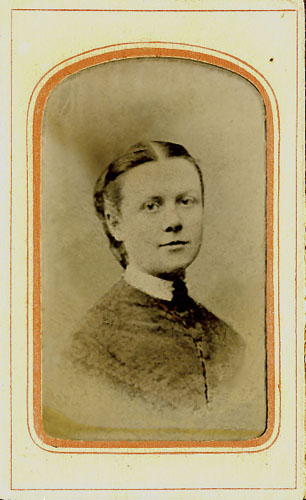24 Apr. 1847–8 May 1875
Susan Dimrock, North Carolina's first woman doctor, was born in Washington, N.C., to Henry Dimock and his wife, Mary Malvina Dimock, daughter of the sheriff of Beaufort County.

Dimock, from Limington, Maine, was one of a group of young New Englanders who moved south in the 1830s and 1840s looking for adventure, and stayed to marry southern women and become solid citizens. For a few years he taught school before becoming editor of the local newspaper, The North State Whig . Following their marriage, the Dimocks acquired the town hotel, The Lafayette. Here their daughter, Susan, was born and spent her girlhood. Across the street lived the family doctor, Dr. Solomon Samson Satchwell. He made a pet of this little girl and sometimes took her with him when he made calls in the country. While still very young she became obsessed with the ambition to become a physician.
Susan Dimock received her elementary education at a small private school and then attended the Washington Academy where Latin became her favorite subject. A brilliant student, she amused herself by translating prescriptions in an ancient pharmacopoeia in Dr. Satchwell's collection. One month before her fifteenth birthday, Union soldiers entered Washington as conquerors and occupied the town for more than two years. Some of the officers made their headquarters at the Lafayette Hotel and the Dimocks were greatly criticized by loyal Confederates for being friendly with them. But, after all, Dimock himself was a Yankee. He lived only a few months after the occupation of Washington, however. A year and a half after his death, the Lafayette was burned to the ground in the holocaust that destroyed most of the town.
In some way Susan and her mother managed to obtain transportation to the home of Dimock's sister near Sterling, Mass., where they lived briefly. Susan attended school in Sterling for six months and then secured a job as a teacher in Hopkinton, Mass. She was then seventeen.
The opportunity to pursue a medical career arose through her close friendship with Bessie Greene, daughter of a wealthy Bostonian. Colonel Greene, Bessie's father, became interested in Susan and her desire to study medicine, an ambition rare in a young woman in the nineteenth century when there were only a few women doctors in the world. Of the two or three in the United States, one was Dr. Marie Zakrzewska, a Polish woman who had received her medical training in Germany. She had come to the United States under the sponsorship of Dr. Elizabeth Blackwell, the first woman doctor in this country. By 1862 Dr. Zakrzewska had established the New England Hospital for Women and Children in a small rented house in Boston. Through the Greenes, Susan met Dr. Zakrzewska who furnished her a list of medical books to study. Not long afterward Dr. Zakrzewska accepted Susan as a student at her hospital.
Opposition to women invading the medical field was particularly bitter. When all efforts to have Susan admitted to Harvard failed, Dr. Zakrzewska urged her to study in Europe. Colonel Greene, convinced of the rare ability and dedication of this unusual young woman, offered to finance her studies in Switzerland where women doctors were welcome. At the University of Zurich Dimock had a brilliant record and in 1871 received a medical degree with honors. Her graduating dissertation was a treatise on "The Different Forms of Puerperal Fever." Before returning to the United States, she pursued specialties in hospitals in Vienna and in Paris.
The American Medical Association, meeting in San Francisco in 1872, expounded feelingly on the dangers of entrusting life to the weak, unstable feminine intelligence. Happily North Carolina was more liberal in its attitude. At the 1872 meeting of the North Carolina Medical Society Susan Dimock was received as an honorary member of the profession—"honorary" because she was in Paris at the time and thus was not present to be examined for her license. Her credentials were submitted by her childhood friend, Dr. S. S. Satchwell of Washington, N.C. Satchwell was highly respected throughout the state and at that time was serving as secretary of the Medical Board.
In July 1872 Dr. Dimock took up duties as resident physician at the Boston hospital where she had matriculated as a student only a few years before. After three years of hard but successful work, she asked for a vacation before renewing her contract with the hospital. The directors were delighted to give her five months' leave for recreation and further study in Europe. Accompanied by her two close friends, Bessie Greene and Caroline Crane, Susan sailed from New York on 27 Apr. 1875 on the Schiller , considered one of the best of the great iron-rigged steam ships of the day. Two weeks later the Schiller, ploughing her way through an impenetrable fog, was wrecked on a granite reef off the Scilly Isles twenty-five miles off the coast of Cornwall, England. Almost all on board were lost. Friends from London identified Susan's body. Her watch had stopped at seven minutes to four so it was assumed that was the hour of her death. Most of the victims of the shipwreck were buried on St. Mary's Island. However, Colonel Greene arranged to have his daughter and her two companions, Susan and Caroline, brought home to Boston where the three were interred in Forest Hills Cemetery.
For weeks the press echoed with tributes to Susan Dimock, pioneer woman doctor. One distinguished physician went on record as saying that he had always been opposed to women doctors until he met Susan Dimock. Her intelligence, her modesty, and her devotion to her work had convinced him that he was wrong.